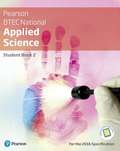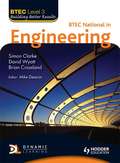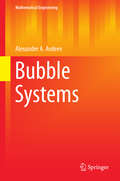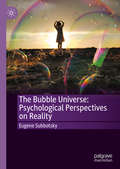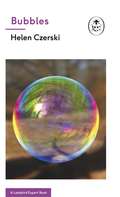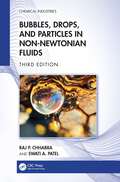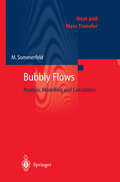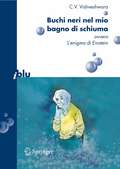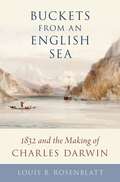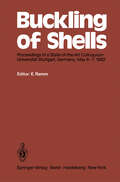- Table View
- List View
BTEC First NG Construction and The Built Environment: Student Book (PDF)
by Simon ToplissThis title covers four core units and a wide selection of optional units providing all the necessary underpinning knowledge. Units are professionally presented in topics so they are easy to dip in and out of and refer to during lessons.
BTEC Level 3 Nationals 2016 Applied Science Student Book (PDF)
by Frances Annets Joanne Hartley Chris Meunier Roy Llewellyn Sue HockingBTEC Level 3 Nationals 2016 Applied Science Student Book
Btec Level 3 Nationals Applied Science Student Book 1 (PDF)
by Joanne Hartley Frances Annets Chris Meunier Roy Llewellyn Sue Hocking Alison Peers Catherine ParmarEach Student Book and ActiveBook has clearly laid out pages with a range of supportive features to aid learning and teaching: - Getting to know your unit sections ensure learners understand the grading criteria and unit requirements. - Getting ready for assessment sections focus on preparation for external assessment with guidance for learners on what to expect. Hints and tips will help them prepare for assessment and sample answers are provided for a range of question types including, short and long answer questions, all with a supporting commentary. - Pause point features provide opportunities for learners to self-evaluate their learning at regular intervals. Each Pause Point feature give learners a Hint or Extend option to either revisit and reinforce the topic or encourage independent research or further study skills. - Case study and Theory into practice features enable development of problem-solving skills and place the theory into real-life situations learners could encounter. - Assessment practice features provide scaffolded assessment practice activities that help prepare learners for assessment. Within each assessment practice activity, a Plan, Do and Review section supports learners' formative assessment by making sure they fully understand what they are being asked to do, what their goals are and how to evaluate the task and consider how they could improve. - Literacy and numeracy activities provide opportunities for reinforcement in these key areas, placing the skills into a sport context. - Dedicated Think future pages provide case studies from the industry, with a focus on aspects of skills development that can be put into practice in a real work environment and further study.
BTEC National Applied Science Revision Workbook
by Chris Meunier Carol Usher Ms Karlee Lees Ann Fullick Cliff CurtisExam Board: Pearson EdexcelAcademic Level: BTEC NationalSubject: Applied ScienceFirst teaching: September 2016First Exams: Summer 2017 For all four of the externally assessed units 1, 3, 5 and 7. Builds confidence with scaffolded practice questions. Unguided questions that allow students to test their own knowledge and skills in advance of assessment. Clear unit-by-unit correspondence between this Workbook and the Revision Guide and ActiveBook.
BTEC National Engineering (PDF)
by David Wyatt Simon Clarke David CrosslandThis exciting new student text covering the core units of the new specification will engage and motivate young engineers. Bursting with full-colour photographs and illustrations, students will find it easy to locate all the information they need, with bite-sized chunks of information all linked to the learning outcomes. Activities to help generate evidence necessary for assessment are also included so that students can easily see what they need to do to gain a pass, merit or distinction.
Bubble Dynamics and Interface Phenomena: Proceedings of an IUTAM Symposium held in Birmingham, U.K., 6–9 September 1993 (Fluid Mechanics and Its Applications #23)
by John R. Blake Jeremy M. Boulton-Stone Neale H. ThomasThis volume contains papers presented at the IUTAM Symposium on Bubble Dynamics and Interface Phenomena held at the University of Birmingham from 6-9 September 1993. In many respects it follows on a decade later from the very successful IUTAM Symposium held at CALTECH in June 1981 on the Mechanics and physics of bubbles in liquids which was organised by the late Milton Plesset and Leen van Wijngaarden. The intervening period has seen major development with both experiment and theory. On the experimental side there have been ad vances with very high speed photography and data recording that provide detailed information on fluid and interface motion. Major developments in both computer hardware and software have also led to extensive improvement in our understand ing of bubble and interface dynamics although development is still limited by the sheer complexity of the laminar and turbulent flow regimes often associated with bubbly flows. The symposium attracts wide and extensive interest from engineers, physical, chemical, biological and medical scientists and applied mathematicians. The sci entific committee sought to achieve a balance between theory and experiment over a range of fields in bubble dynamics and interface phenomena. It was our intention to emphasise both the breadth and recent developments in these various fields and to encourage cross-fertilisation of ideas on both experimental techniques and theo retical developments. The programme, and the proceedings recorded herein, cover bubble dynamics, sound and wave propagation, bubbles in flow, sonoluminescence, acoustic cavitation, underwater explosions, bursting bubbles and ESWL.
Bubble Dynamics and Shock Waves (Shock Wave Science and Technology Reference Library #8)
by Can F. DelaleThis book explores the interplay of bubble dynamics and shock waves, covering shock wave emission by laser generated bubbles, pulsating bubbles near boundaries, interaction of shock waves with bubble clouds, applications in shock wave lithotripsy, and more.
Bubble Systems (Mathematical Engineering)
by Alexander A. AvdeevThis monograph presents a systematic analysis of bubble system mathematics, using the mechanics of two-phase systems in non-equilibrium as the scope of analysis. The author introduces the thermodynamic foundations of bubble systems, ranging from the fundamental starting points to current research challenges. This book addresses a range of topics, including description methods of multi-phase systems, boundary and initial conditions as well as coupling requirements at the phase boundary. Moreover, it presents a detailed study of the basic problems of bubble dynamics in a liquid mass: growth (dynamically and thermally controlled), collapse, bubble pulsations, bubble rise and breakup. Special emphasis is placed on bubble dynamics in turbulent flows. The analysis results are used to write integral equations governing the rate of vapor generation (condensation) in non-equilibrium flows, thus creating a basis for solving a number of practical problems. This book is the first to present a comprehensive theory of boiling shock with applications to problems of critical discharge and flashing under the fast decompression conditions. Reynolds’ analogy was the key to solving a number of problems in subcooled forced-flow boiling, the theoretical results of which led to easy-to-use design formulas. This book is primarily aimed at graduate and post-graduate students specializing in hydrodynamics or heat and mass transfer, as well as research expert focused on two-phase flow. It will also serve as a comprehensive reference book for designers working in the field of power and aerospace technology.
The Bubble Universe: Psychological Perspectives on Reality
by Eugene SubbotskyThis book examines the role that human subjective experience plays in the creation of reality and introduces a new concept, the Bubble Universe, to describe the universe as it looks from the subjective viewpoint of an individual. Drawing on a range of research, the author questions the extent to which the scientific study of the origins of life, consciousness and subjective experience is itself influenced by scientists’ subjective worlds.The author argues that in many respects the Bubble Universe differs from the universe as described by science and religion, and analyzes these differences. The fabric and structure of subjective reality is described, and various aspects of the Bubble Universe are examined, including science, religion, life, morality and history. The differences between the views from inside the subjective universe and from scientific, religious and sociocultural versions of the universe are outlined, and their significance for practical and theoretical problems are highlighted and illustrated with psychological experiments. This book will be of value to all scholars interested in how subjectivity influences research and appeal in particular to those working in developmental and theoretical psychology, consciousness, epistemology, phenomenology, and the philosophy of science and of the mind.
Bubbles: A Ladybird Expert Book (The Ladybird Expert Series)
by Helen CzerskiPart of the new Ladybird Expert series, Bubbles is a clear, surprising and entertaining introduction to the science of bubbles. Bubbles are beautiful, ephemeral, fun, fragile, jolly and slightly unpredictable. We're all familiar with them, but we don't often ask what they actually are. The great scientists of the Western world - Robert Hooke, Isaac Newton, Lord Rayleigh and more - studied bubbles seriously. They recognised that they had a lot to say about the nature of the physical world, and they poked, prodded and listened to find out what it was. In the years since, we've learned that this bulbous arrangement of liquid and gas does things that neither the gas or the liquid could do by itself. Written by the celebrated physicist and oceanographer Helen Czerski, Bubbles explores how everything from the way drinks taste to the Earth's temperature are influenced by bubbles. This book has a message: never underestimate a bubble!
Bubbles, Booms, and Busts: The Rise and Fall of Financial Assets
by Donald RappThis book deals at some length with the question: Since there are many more poor than rich, why don’t the poor just tax the rich heavily and reduce the inequality? In the 19th century and the first half of the 20th century, the topic of inequality was discussed widely. Ending or reducing inequality was a prime motivating factor in the emergence of communism and socialism. The book discusses why later in the 20th century, inequality has faded out as an issue. Extensive tables and graphs of data are presented showing the extent of inequality in America, as well as globally. It is shown that a combination of low taxes on capital gains contributed to a series of real estate and stock bubbles that provided great wealth to the top tiers, while real income for average workers stagnated. Improved commercial efficiency due to computers, electronics, the Internet and fast transport allowed production and distribution with fewer workers, just as the advent of electrification, mechanization, production lines, vehicles and trains in the 1920s and 1930s produced the same stagnating effect.
Bubbles, Booms, and Busts: The Rise and Fall of Financial Assets
by Donald RappThis book provides a thorough explanation of the nature and history of booms, bubbles and busts in financial markets. The first part of the book deals with financial booms and bubbles and how they emerge, develop and collapse. It describes the distribution of wealth, inflation, rationality of bankers, monetary and fiscal policy, the role of central banks, tax policies, social security, US federal, state, municipal and personal debt, and valuation of common stocks. The book describes historical boom/bust cycles including bubbles of the 1720s, the Florida land boom and the stock market in the 1920s, the depression of the 1930s, the S&L scandal of the 1980s, the great bull market of 1982-1995, the crash of 1987, the dot.com mania of 1995-2000, corporate swindles of the 1990s and 2000s, the sub-prime fiasco of the 2000s, and Japan in the late 20th century. Most of the recent wealth generation has derived from increased debt and appreciation of paper assets. The architects of the new economics were Ronald Reagan and Arthur Greenspan. Inevitably, the US Government’s cure for excessive spending and inadequate revenues is to increase spending and cut revenues. American voters must choose between “tax and spend” Democrats and “spend and borrow” Republicans. The theme of American finance was uttered by VP Cheney: “Deficits don’t matter”.
Bubbles, Drops, and Particles in Non-Newtonian Fluids (Chemical Industries)
by Raj P. Chhabra Swati A. PatelThe third edition of Bubbles, Drops, and Particles in Non-Newtonian Fluids provides comprehensive coverage of the scientific foundations and the latest advances in particle motion in non-Newtonian media. Thoroughly updating and expanding its best-selling predecessor, this edition addresses numerical and experimental developments in non-Newtonian particulate systems. It includes a new chapter on heat transfer in non-Newtonian fluids in the free and mixed convection regimes and thus covers forced convection regimes separately in this edition. Salient Features: Demonstrates how dynamic behavior of single particles can yield useful information for modeling transport processes in complex multiphase flows. Addresses heat transfer in Generalized Newtonian Fluid (GNF), visco-plastic and visco-elastic fluids throughout the book and outlines potential strategies for heat transfer enhancement. Provides a new detailed section on the effect of confinement on heat transfer from bluff-bodies in non-Newtonian fluids. Written in a clear and concise manner, this book remains an excellent handbook and reference. It is essential reading for students and researchers interested in exploring particle motion in different types of non-Newtonian systems encountered in disciplines across engineering and the sciences.
Bubbles, Drops, and Particles in Non-Newtonian Fluids (Chemical Industries)
by Raj P. Chhabra Swati A. PatelThe third edition of Bubbles, Drops, and Particles in Non-Newtonian Fluids provides comprehensive coverage of the scientific foundations and the latest advances in particle motion in non-Newtonian media. Thoroughly updating and expanding its best-selling predecessor, this edition addresses numerical and experimental developments in non-Newtonian particulate systems. It includes a new chapter on heat transfer in non-Newtonian fluids in the free and mixed convection regimes and thus covers forced convection regimes separately in this edition. Salient Features: Demonstrates how dynamic behavior of single particles can yield useful information for modeling transport processes in complex multiphase flows. Addresses heat transfer in Generalized Newtonian Fluid (GNF), visco-plastic and visco-elastic fluids throughout the book and outlines potential strategies for heat transfer enhancement. Provides a new detailed section on the effect of confinement on heat transfer from bluff-bodies in non-Newtonian fluids. Written in a clear and concise manner, this book remains an excellent handbook and reference. It is essential reading for students and researchers interested in exploring particle motion in different types of non-Newtonian systems encountered in disciplines across engineering and the sciences.
Bubbly Flows: Analysis, Modelling and Calculation (Heat and Mass Transfer)
by Martin SommerfeldThe book summarises the outcom of a priority research programme: 'Analysis, Modelling and Computation of Multiphase Flows'. The results of 24 individual research projects are presented. The main objective of the research programme was to provide a better understanding of the physical basis for multiphase gas-liquid flows as they are found in numerous chemical and biochemical reactors. The research comprises steady and unsteady multiphase flows in three frequently found reactor configurations, namely bubble columns without interiors, airlift loop reactors, and aerated stirred vessels. For this purpose new and improved measurement techniques were developed. From the resulting knowledge and data, new and refined models for describing the underlying physical processes were developed, which were used for the establishment and improvement of analytic as well as numerical methods for predicting multiphase reactors. Thereby, the development, lay-out and scale-up of such processes should be possible on a more reliable basis.
Buchführung und Bilanz: Methodische Einführung mit Übungsaufgaben und Lösungen
by Kurt Hesse Rolf FralingBuchhaltung und Bilanz: auf wirtschaftlicher, rechtlicher und mathematischer Grundlage für Juristen, Ingenieure, Kaufleute und Studierende der Betriebswirtschaftslehre
by Johann Friedrich Schär W. PrionDieser Buchtitel ist Teil des Digitalisierungsprojekts Springer Book Archives mit Publikationen, die seit den Anfängen des Verlags von 1842 erschienen sind. Der Verlag stellt mit diesem Archiv Quellen für die historische wie auch die disziplingeschichtliche Forschung zur Verfügung, die jeweils im historischen Kontext betrachtet werden müssen. Dieser Titel erschien in der Zeit vor 1945 und wird daher in seiner zeittypischen politisch-ideologischen Ausrichtung vom Verlag nicht beworben.
Buchi neri nel mio bagno di schiuma ovvero l'enigma di Einstein (I blu)
by C.V. Vishveshwara"Le bolle stavano turbinando tutto intorno a me e massaggiavano il mio corpo ... Mentre me la godevo in questo fantastico bagno di bolle, i miei occhi si fecero pesanti e mi lasciaii trasportare in un dormiveglia sublimamente estatico". Così inizia l’incontro di Alfie con una vasca da bagno eccezionale e rivelatrice, acquistata da un vicino misterioso di nome Al. L’Enigma di Einstein, ovvero buchi neri nel mio bagno di schiuma, racconta la storia della teoria della gravitazione, dai suoi primordi fino agli ultimi sviluppi in astrofisica, focalizzandosi sulla teoria della relatività generale di Albert Einstein e sulla fisica dei buchi neri. Tramite conversazioni avvincenti e diagrammi scarabocchiati su tovaglioli di carta, si susseguono a ruota i rudimenti della relatività, dello spazio-tempo e di molti aspetti della fisica moderna. In scenette narrate con abilità pedagogica e notevole talento letterario, il lettore s’imbatterà nelle lezioni informali che un astrofisico cosmopolita tiene al suo amico Alfie, organizzatore free lance di progetti di ricerca. Unitevi al divertimento intellettuale ed emozionatevi con le idee spumeggianti, mentre con la fantasia vi godete un rilassante bagno in questa vasca magica!
Buckets from an English Sea: 1832 and the Making of Charles Darwin
by Louis B. RosenblattDarwin did not discover evolution. He didn't trip over it on the way to somewhere else the way Columbus discovered the New World. Like the atom, planetary orbits, and so many other scientific constructs, evolution was invented in order to explain striking phenomena. And it has been most successful. A century and a half has not simply confirmed Darwin's work, it has linked evolution to the mechanisms of life on the molecular scale. It is what life does. Where Darwin had drawn his theories from forest and field, we now set them in the coiling and uncoiling of twists of DNA, linking where they might, with a host of molecular bits and pieces scurrying about. Darwin, himself, however, has been a closed story. A century and a half of study of the man and his work, including close readings of his books, his notebooks and letters, and even the books he read, has led to a working appreciation of his genius. The 'success' of this account has, however, kept us from seeing several important issues: most notably, why did he pursue evolution in the first place? Buckets from an English Sea offers a new view of what inspired Darwin and provoked his work. Stunning events early in the voyage of the Beagle challenged his deeply held conviction that people are innately good. This study of 1832 highlights the resources available to the young Darwin as he worked to secure humanity's innate goodness.
Buckets from an English Sea: 1832 and the Making of Charles Darwin
by Louis B. RosenblattDarwin did not discover evolution. He didn't trip over it on the way to somewhere else the way Columbus discovered the New World. Like the atom, planetary orbits, and so many other scientific constructs, evolution was invented in order to explain striking phenomena. And it has been most successful. A century and a half has not simply confirmed Darwin's work, it has linked evolution to the mechanisms of life on the molecular scale. It is what life does. Where Darwin had drawn his theories from forest and field, we now set them in the coiling and uncoiling of twists of DNA, linking where they might, with a host of molecular bits and pieces scurrying about. Darwin, himself, however, has been a closed story. A century and a half of study of the man and his work, including close readings of his books, his notebooks and letters, and even the books he read, has led to a working appreciation of his genius. The 'success' of this account has, however, kept us from seeing several important issues: most notably, why did he pursue evolution in the first place? Buckets from an English Sea offers a new view of what inspired Darwin and provoked his work. Stunning events early in the voyage of the Beagle challenged his deeply held conviction that people are innately good. This study of 1832 highlights the resources available to the young Darwin as he worked to secure humanity's innate goodness.
Buckling and Postbuckling of Beams, Plates, and Shells (Structural Integrity #1)
by M. Reza EslamiThis book contains eight chapters treating the stability of all major areas of the flexural theory. It covers the stability of structures under mechanical and thermal loads and all areas of structural, loading and material types. The structural element may be assumed to be made of a homogeneous/isotropic material, or of a functionally graded material. Structures may experience the bifurcation phenomenon, or they may follow the postbuckling path. This volume explains all these aspects in detail. The book is self-contained and the necessary mathematical concepts and numerical methods are presented in such a way that the reader may easily follow the topics based on these basic tools. It is intended for people working or interested in areas of structural stability under mechanical and/or thermal loads. Some basic knowledge in classical mechanics and theory of elasticity is required.
Buckling of Shells: Proceedings of a State-of-the-Art Colloquium, Universität Stuttgart, Germany, May 6–7, 1982
by Ekkehard RammThin shells are very popular structures in many different branches of engineering. There are the domes, water and cooling towers, the contain ments in civil engineering, the pressure vessels and pipes in mechanical and nuclear engineering, storage tanks and platform components in marine and offshore engineering, the car bodies in the automobile industry, planes, rockets and space structures in aeronautical engineering, to mention only a few examples of the broad spectrum of application. In addition there is the large applied mechanics group involved in all the computational and experimental work in this area. Thin shells are in a way optimal structures. They play the role of·the "primadonnas" among all kinds of structures. Their performance can be extraordinary, but they can also be very sensitive. The susceptibility to buckling is a typical example. David Bushnell says in his recent review paper entitled "Buckling of Shells - Pitfall for DeSigners": "To the layman buckling is a mysterious, perhaps even awe inspiring phenomenon that transforms objects originally imbued with symmetrical beauty into junk".
Buckling of Ship Structures
by Mohamed ShamaBuckling of Ship Structures presents a comprehensive analysis of the buckling problem of ship structural members. A full analysis of the various types of loadings and stresses imposed on ship plating and primary and secondary structural members is given. The main causes and consequences of the buckling mode of failure of ship structure and the methods commonly used to control buckling failure are clarified. This book contains the main equations required to determine the critical buckling stresses for both ship plating and the primary and secondary stiffening structural members. The critical buckling stresses are given for ship plating subjected to the induced various types of loadings and having the most common boundary conditions encountered in ship structures. The text bridges the gap existing in most books covering the subject of buckling of ship structures in the classical analytical format, by putting the emphasis on the practical methods required to ensure safety against buckling of ship structural members. It is very useful to ship designers, shipyard engineers, naval architects, international classification societies and also to students studying naval architecture, marine engineering and offshore structures. It is a valuable source for practicing naval architects to quickly check the possibility of buckling of ship structure members without reverting to the complex and costly analysis using advanced FEM software.
Buckling of Structures: Symposium Cambridge/USA, June 17–21, 1974 (IUTAM Symposia)
by B. BudianskyThis volume contains the written texts of the papers presented at a Symposium on Buckling of Structures held at Harvard University in June 1974. This symposium, one of several on various topics sponsored annually by the International Union of Theoretical and Applied Me chanics (IUTAM), was organized by a Scientific Committee consisting of B. Budiansky (Chairman), A. H. Chilver, W. T. Koiter, and A. S. Vol' mir. Participation was by invitation of the Scientific Committee, and specific lecturers were invited to speak in the areas of experimental research, buckling and post-buckling calculations, post-buckling mode interaction, plasticity and creep effects, dynamic buckling, stochastic problems, and design. A total of 29 lectures were delivered, including a general opening lecture by Professor Koiter, and there were 93 reg istered participants from 16 different countries. Financial support for the symposium was provided by IUTAM, in the form of partial travel support for a number of participants, and also by the National Science Foundation, the National Aeronautics and Space Administration, and the Air Force Office of Scientific Re search, for additional travel support and administrative expenses. Meeting facilities and services were efficiently provided by the Science Center of Harvard University, and administrative support was gen erously provided by the Division of Engineering and Applied Physics of Harvard University. The scientific chairman enjoyed the invaluable assistance of his colleagues Professors J. W. Hutchinson and J. L.

